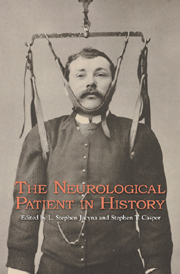Book contents
- Frontmatter
- Contents
- Preface
- Acknowledgments
- Introduction
- Part One Medicine Constructs the “Neurological Patient”
- Part Two Public and Private Constructions of the “Neurological Patient”
- Part Three Patient Groups Construct the “Neurological Patient”
- Part Four The Patient Constructs the “Neurological Patient”
- Part Five Historians Construct the “Neurological Patient”
- 9 Neuropatients in Historyland
- 10 The Neurological Patient in History: A Commentary
- Bibliography
- List of Contributors
- Index
9 - Neuropatients in Historyland
from Part Five - Historians Construct the “Neurological Patient”
Published online by Cambridge University Press: 12 September 2012
- Frontmatter
- Contents
- Preface
- Acknowledgments
- Introduction
- Part One Medicine Constructs the “Neurological Patient”
- Part Two Public and Private Constructions of the “Neurological Patient”
- Part Three Patient Groups Construct the “Neurological Patient”
- Part Four The Patient Constructs the “Neurological Patient”
- Part Five Historians Construct the “Neurological Patient”
- 9 Neuropatients in Historyland
- 10 The Neurological Patient in History: A Commentary
- Bibliography
- List of Contributors
- Index
Summary
If the patient is the hole at the center of the history of the neurological patient, it is only in the sense of an invisible performing subject. The concept of the patient has never been missing. It is implicit to the history of neurology, as it is to the rest of the history of medicine. Like all concepts and categories, however, it is a shifting product of its historical times. It moves with its historiography. In illustration of this, we need look no further than the contributions to this volume by Stephen Casper and Jesse Ballenger. Like other chapters, their essays usefully draw our attention to the importance of talking about patients in the history of neurology and in the “psy” sciences more generally. They remind us that it is in these areas of professional practice above all that talking matters—the talking, that is, of patients. Since it is very often only through the patient's voice that expertise is constituted in the domains of neurology, psychology, and psychiatry, the subjectivity of the patient is the name of the game. If there is no verbally constituted subjectivity, then there is no game. (Or perhaps we should say was no game, for brain mapping appears to be taking over the process of defining the interior of the patient subject.) But what the chapters by Casper and Ballenger also reveal, at an implicit level, is the discursive nature of the concept of the patient, and how its framing is peculiar to its historical moment.
- Type
- Chapter
- Information
- The Neurological Patient in History , pp. 215 - 222Publisher: Boydell & BrewerPrint publication year: 2012



